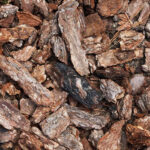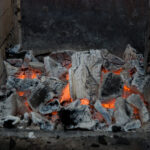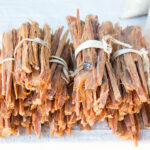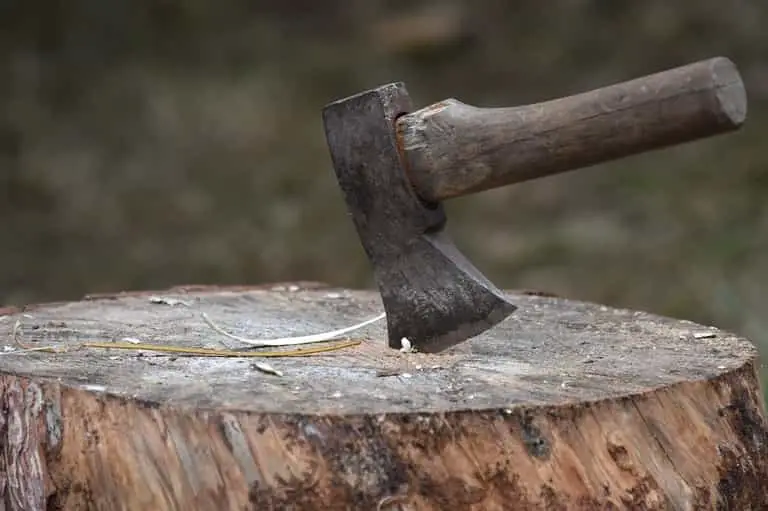
Whether you’re an outdoor adventurer or a survivalist, it’s essential to have at least one or more bladed tools to cut, dig, chop, or even destroy things (in a crisis).
In this article, I’m going to analyze the Tomahawk vs Machete; which one is the right tool for you?
Table of Contents
- Tomahawk vs Machete
- Comparison Table
- Definitions
- Tomahawk Features
- Machete Features
- Uses and Applications of a Tomahawk
- Uses and Applications of a Machete
- Which One Should You Choose?
- Final Thoughts
Tomahawk vs Machete
A tomahawk is a form of small one-handed axe designed with a thin head and can serve more than one purpose. It has a blade side that’s essential for cutting and chopping as well as a poll side that can be used for hammering, digging, breaking, or blunt force. On the other hand, a machete is a versatile slashing tool with a long blade that can be used to efficiently clear bushes and vines and also be used as a light-duty ax.
So before choosing one to take out with you to your outdoor adventures, or in your urban survival prep kit- it’s important to know their optimal uses, the pros and cons, and how they compare.
Comparison Table
| Tomahawk | Machete |
| Perfect for hunting and wood cutting | Used for light and moderate cutting or slashing |
| Has a removable head with narrow cutting edge | Has a long blade (measuring about 10 to 28 inches long) with no removable part |
| Has a long handle (measuring about 14 – 21 inches long) length | Has a short handle length |
| Compact, lightweight, and easy to carry | The long blade makes it difficult to carry, especially if you want to pack it in a backpack |
| A bit heavier at 1 – 1.5 lbs | Lighter at about 0.9 lbs |
| Very versatile as the head can be used for cutting, hammering, chopping, digging, and breaking | Can be used for more than just moderate cutting and chopping |
Definitions
To clearly understand these tools and how they differ, let’s briefly define them.
Tomahawk
Commonly associated with the indigenous people of North America, a tomahawk is a general-purpose ax that has been modified to be used for both cutting and hammering.
A tomahawk is designed with a one-sided blade to resemble a hatchet but with an additional beard section that can be used for hammering or penetrative purposes.
Machete
Resembling a knife with an extra-long blade, a machete is mainly designed for cutting and chopping through dense but light vegetation such as long grass and vines, as well as flesh and bone.
Depending on which part of the globe you come from, machetes have evolved in many different types such as kukri, parang, panga, bowie, barong, and many more. While they all have unique applications, their features remain the same.
Tomahawk Features
Let’s compare their features.
Head Design
A tomahawk comes with a thin head design that serves more than one purpose. It has the following three head styles:
- Single blade – It resembles a light hatchet with its one-sided edge.
- Double blade – The head design is an ax with sharp edges on both sides.
- Single blade with a spike – This is the most common type of tomahawk. It has a sharp blade on one side and either a hammer, spike, or blunt tip on the other side.
Removable Head
One thing that makes a tomahawk very different from a machete, or any other tool for that matter, is its removable head. You can easily detach the head from the long handle and pack it in your backpack for easier portability.
Handle Length
Tomahawk handles usually measure between 14 inches and 21 inches. This long handle is essential in offering leverage when using the tomahawk to split wood, chop trees, hammer through rigid materials, break locks, and even when using the tomahawk for self-defense!
Cutting Edge
The cutting edge of a tomahawk is designed to be narrow and thin to enable it to pierce deeper with little force.
Weight and Size
Tomahawks are generally compact with lightweight axes, which make them easy to carry when camping or hiking. Its size gives it a balanced weight, which makes it ideal for combat sports and self-defense.
Durability
The axes are made from high-quality steel that offers durability and is impact-resistant. The handles are either made of composite handles or hardwood to last long.
Price
A tomahawk can cost between $50 and $200 or even higher depending on the materials used and its design.
Machete Features
Although there are different types, styles, and lengths of machetes, their main features remain the same.
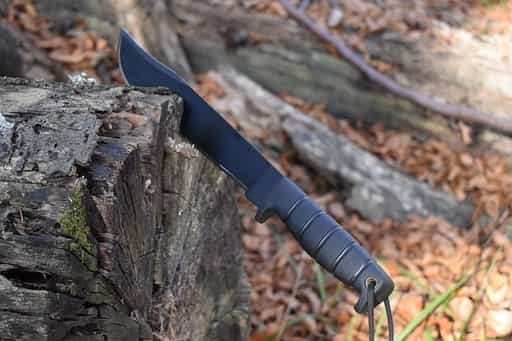
Blade Design
Machete blades range between 10 inches and 28 inches. Those that are designed with shorter blades are easier to pack and offer more agility. On the other hand, machetes with longer blades offer longer swing arcs and are perfect for clearing larger areas quickly.
The edges of the blades may also be sharpened differently or even on both sides depending on the intended purpose of the machete.
Handle
The handle is the shortest part of the machete and can be made from wood, plastic, or Micarta. It should be designed to offer a comfortable grip.
Weight
Given that machetes are meant for clearing and cutting, they should be lightweight but sturdy. The blade should be relatively thin but long.
Sheath
Most machetes come with sheaths that are meant to protect their blades and the users when not in use. You can use the sheath to carry the machete around by attaching it to your belt or placing it inside your tool bag.
Price
The price of a machete is between $20 and $200 depending on the materials used to design it and where you buy it.
Uses and Applications of a Tomahawk
Today’s standard tomahawks are designed as versatile tools that can be used to perform many functions including splitting firewood, making shelter, cutting, as well as for digging, hammering, and personal protection.
When compared to a machete, a tomahawk can perform a wide range of tasks that you wouldn’t otherwise perform with a machete alone.
In addition to being a very versatile tool, you can use a tomahawk as a combat tool to either block blows from an attacker or for hunting.
This is, without a doubt, a very practical and indestructible tool that can destroy any rigid material if used properly. The ax of a tomahawk may be small in size but it’s designed to perform heavy-duty tasks that you wouldn’t manage with a machete.
Pros
- Removable head
- Lightweight
- Versatile
- Three-blade options
- Robust and sturdy construction
- Very durable
Cons
- Not great for splitting large firewood
- Not heavy enough for certain work application
- Limited slicing or skinning capabilities
- Requires frequent sharpening
Uses and Applications of a Machete
The lightweight design of a machete gives it a distinct advantage over a tomahawk as part of a daily life tool.
This is because you can use it to cut and maintain trails, as well as clear bushes; something that a tomahawk cannot do. You can as well use it to chop down compost into small pieces so that it breaks down quickly.
As far as agriculture is concerned, you can use a machete to harvest various crops including sugar cane, rice, millet, corn, rye, oats, buckwheat, and many more.
You can also use a machete to remove dead plant residue or cover crops from your garden by scalping the above-ground vegetation to leave root biomass in place.
That’s not all; you can use a machete for fruit and nut splitting (coconut is a perfect example), for hunting (for butchering wild game, livestock, and poultry), for survival (fending off angry animals and venomous snakes), and for camp management.
In essence, a machete is a classic must-have tool. Whether you want to build a campsite or use it as a normal tool in your daily life, it can perform a load of functions.
Pros
- Long and heavy-duty blade
- Low maintenance
- Offers a longer reach
- Easy to use
- Great functionality and versatility
Cons
- Limited carry options
- Not easy to conceal
- Not capable of splitting wood
- Less durability than a Tomahawk
Which One Should You Choose?
A tomahawk and a machete are two very different tools, so it depends on what you want to do and your situation. A tomahawk can be used for cutting, chopping, digging, hammering, and light-medium duty work.
On the other hand, a machete can be ideal for clearing bushes and vegetation, for farm work, butchering wild game or livestock, and for campsite maintenance. And even though a machete reigns supreme in terms of what it can do, you should consider having both as shown in this insightful video.
Final Thoughts
In an urban setting: My pick would be Tomahawk.
In any outdoor setting, my pick would be Machete.
Ok, and If I had to choose one…and only one…I would choose the Machete. And here is why:
The Machete can do everything a Tomahawk can do (albeit not nearly as good). However, a Tomahawk cannot do everything a machete can.
Take for example clearing thick brush and vegetation. You would never get anywhere trying to clear thick grass, vines and bushes with a Tomahawk. The blade design is simply not meant for that type of work.
On the flip side, you may ask well can you chop firewood with a machete? Yes. Can you do it well? No, not really…but you can make it work, especially using a wooden baton.
Thanks for reading…I hope this article got your wheels spinning!
You May Also Like: Machete vs Cutlass: Differences & Uses Explained!

